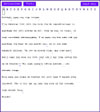 |
 |
 |
by Rick Groleau You could do worse than to confuse the meanings of "code" and "cipher"—even cryptographers sometime use the terms as though they had the same meaning. There is, however, a definite distinction between the two. Codes are letter combinations or symbols used to represent words or concepts. A "10-4" heard over a police radio means "affirmative," for example; and three dots, three dashes, and three dots (...---...) in Morse code stands for the distress message "SOS." A cipher, on the other hand, is a message in which letters or symbols replace the actual letters in the message. Every cipher has a "key"—information used to decipher a message. Some ciphers have simple keys, others, complex ones. The key for a cipher used by Augustus Caesar, some 2,000 years ago, was simple enough: The receiver just had to shift the alphabet one position. In other words, "a" was represented by "b," "b" was represented by "c," and so on. (Bo fbtz djqifs up csfbl!) How easy is it to crack a simple cipher? This feature lets you find out. On the following page is a secret message encrypted using a cipher. The cipher's key is straightforward—each letter of the alphabet is represented by another letter. Are you ready to decipher? Then let's get to work!
Crack the Ciphers | Send a Coded Message | A Simple Cipher Are Web Transactions Safe? | Mind of a Codebreaker | How the Enigma Works Resources | Teacher's Guide | Transcript | Site Map | Decoding Nazi Secrets Home Editor's Picks | Previous Sites | Join Us/E-mail | TV/Web Schedule About NOVA | Teachers | Site Map | Shop | Jobs | Search | To print PBS Online | NOVA Online | WGBH © | Updated November 2000 |
 Solve A Simple Cipher (26K)
Solve A Simple Cipher (26K)